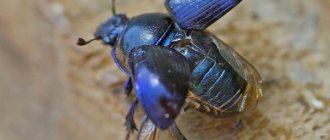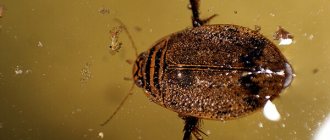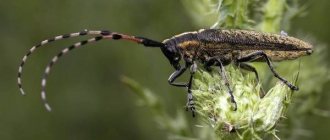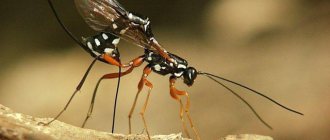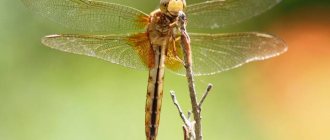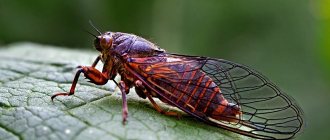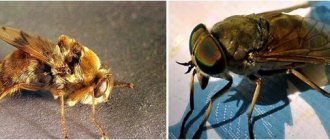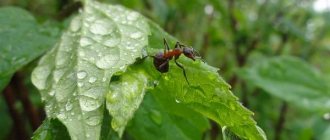- Wild animals
- >>
- Insects
The dung beetle , a member of the Lamelidae family and the subfamily Scarabaeidae, also called the dung beetle, is an insect that forms dung into a ball using its paddle head and paddle-shaped antennae. In some species the ball can be the size of an apple. At the beginning of summer, the dung beetle buries itself in the ball and feeds on it. Later in the season, the female lays eggs in dung balls, which the larvae then feed on.
Origin of the species and description
Photo: Dung beetle
Dung beetles evolved at least 65 million years ago as dinosaurs declined and mammals (and their droppings) grew larger. There are about 6,000 species worldwide, concentrated in the tropics, where they feed primarily on the dung of terrestrial vertebrates.
The sacred scarab of ancient Egypt (Scarabaeus sacer), found in many paintings and jewelry, is a dung beetle. In Egyptian cosmogony there is a scarab beetle rolling a ball of dung and a ball representing the Earth and the Sun. Six branches, each with five segments (30 in total), represent the 30 days of each month (in fact, this species only has four segments on its feet, but closely related species have five segments).
Video: Dung beetle
An interesting member of this subfamily is Aulacopris maximus, one of the largest species of dung beetles found in Australia, reaching a length of 28 mm.
Interesting fact: Indian scarabs Heliocopris and some Catharsius species make very large dung balls and cover them with a layer of clay, which becomes dry; they were once thought to be old stone cannonballs.
Members of other scarab subfamilies (Aphodiinae and Geotrupinae) are also called dung beetles. However, instead of forming balls, they dig a chamber under a pile of dung, which is used during feeding or to store eggs. Aphodian beetle droppings are small (4 to 6 mm) and typically black with yellow spots.
The Geotrupes dung beetle is approximately 14 to 20 mm in length and is brown or black in color. Geotrupes stercorarius, known as the common dung beetle, is a common European dung beetle.
Interesting Facts
- The dung beetle can navigate by the sun and stars, this is the conclusion scientists made by observing hardworking insects. When moving a load, beetles often move backwards to forwards. Pushing the dung ball with their hind legs, they do not lose direction. Having climbed onto a hill, adults are able to determine the path to their burrow. In the dark, beetles navigate by the stars or the moon. In cloudy weather it takes them much longer to roll the ball to the shelter.
- The sacred scarab is a type of dung beetle. A black shiny beetle in ancient Egypt actively rolled balls of dung. This action was believed to symbolize the movement of the sun across the sky.
- Dung beetles are able to obtain moisture from fog. They open their wings, on which droplets of dew settle.
Appearance and features
Photo: What a dung beetle looks like
Dung beetles are usually round with short wings (elytra) that expose the end of the abdomen. They vary in size from 5 to 30 mm and are usually dark in color, although some have a metallic sheen. In many species, the males have a long, curved horn on their head. Dung beetles can eat more than their weight in 24 hours and are considered beneficial to humans because they speed up the process of converting dung into substances used by other organisms.
Dung beetles have impressive "weapons", large horn-like structures on the head or thorax, which males use to fight. They have spurs on their hind legs that help them roll dung balls, and their strong front legs are good for both wrestling and digging.
Most dung beetles are strong fliers, with long flight wings folded under hardened outer wings (elytra), and can travel several kilometers in search of the perfect dung. Using special antennas, they can smell manure from the air.
Even a small ball of fresh dung can be pushed up to 50 times the weight of a particular dung beetle. Dung beetles require exceptional strength, not only to push dung pellets but also to fend off male competitors.
Fun fact: The individual strength record goes to the dung beetle Onthphagus taurus, which can withstand a load equivalent to 1,141 times its own body weight. How does this relate to human feats of strength? It would be like a man pulling 80 tons.
Where does the dung beetle live?
Photo: Dung beetle in Russia
The widespread family of dung beetles (Geotrupidae) contains more than 250 different species that are distributed throughout the globe. About 59 species live in Europe. Dung beetles mainly live in forests, fields and meadows. They avoid climates that are too dry or too wet, so they can be found in subtropical and temperate climate zones.
Dung beetles are found on every continent except Antarctica.
They also live in the following places:
- farmland;
- forests;
- meadows;
- prairies;
- in desert habitats.
They are most often found in deep caves, feeding on copious amounts of bat dung and in turn preying on other giant invertebrates that roam the dark passages and walls.
Most dung beetles use the dung of herbivores, which do not digest food well. Their manure contains semi-digested grass and a smelly liquid. It is this liquid that adult beetles feed on. Some of them have special mouthpieces designed to suck out this nutritious soup, which is full of microorganisms that the bugs can digest.
Some species feed on carnivore dung, while others skip it and instead eat mushrooms, carrion, and decaying leaves and fruits. The shelf life of manure is very important for dung beetles. If the manure has been sitting around long enough to dry out, the beetles cannot suck out the nutrition they need. One study in South Africa found that dung beetles lay more eggs during the rainy season, when they contain more moisture.
Ecological significance
Dung beetles are used on dairy and livestock farms to solve animal excrement disposal problems. When insects crawl through manure to develop their offspring, the number of objects where insects and bacteria harmful to humans and animals can develop is minimized. This is especially true for flies, which do not miss a single heap of manure, after which they can fly into a person’s house and sit on food. In turn, they supply the soil with organic components, which increases its fertility.
What does the dung beetle eat?
Photo: Insect dung beetle
Dung beetles are coprophagous insects, meaning they eat the excrement of other organisms. Although not all dung beetles feed exclusively on dung, they all do so at some point in their lives.
Most prefer to feed on grass dung, which is largely undigested plant matter, rather than carnivore waste, which has very little nutritional value for insects.
Recent research from the University of Nebraska suggests that dung beetles are most attracted to omnivorous droppings because they provide both nutritional value and the right amount of scent to make it easy to find. They are fussy eaters, selecting large pieces of dung and breaking them down into tiny particles, ranging in size from 2-70 microns (1 micron = 1/1000 of a millimeter).
Fun Fact: All organisms require nitrogen to build proteins such as muscles. Dung beetles get them from manure. By eating it, dung beetles can take cells from the intestinal wall of the herbivore that produced it. It is a protein-rich source of nitrogen.
Recent research suggests that obesity and diabetes in humans may be linked to our individual gut microbiomes. Dung beetles can use their gut microbiome to help them digest complex components of dung.
Benefits for the environment
The dung beetle rolls balls out of garbage for a reason. Removes droppings to help clean up the area. By burying manure, beetles fertilize the soil. In addition, dung beetles facilitate the dispersal of plant seeds over long distances.
Scientists have demonstrated the invaluable contribution of burrowing beetles to the well-being of ecosystems associated with industrial animal agriculture.
Interesting fact! In the 1960s, Australian authorities were concerned about the problem of removing manure that was left on fields and meadows as animal waste. Evolutionarily endemic species (inhabiting a certain territory) could only process solid feces of local marsupial inhabitants. Dung beetles were brought to Australia from other countries, whose digestion was adapted to process cow “sweets”. In just one season, the dung beetles completed the task.
Reducing the amount of manure reduces the number of flies that carry diseases that are dangerous to livestock. By recycling livestock waste, dung beetles reduce methane and greenhouse gas emissions by 40%.
The tunnels dug by dung beetles enrich the soil with oxygen.
Features of character and lifestyle
Photo: Ball of dung beetle
Scientists group dung beetles according to how they make their living:
- rollers form a little manure into a lump, roll it away and bury it. The balls they make are used either by the female to lay eggs (called a fuzzy ball) or as food for the adults;
- tunnellers land on a patch of dung and simply dig into the patch, burying some of the dung;
- the inhabitants are content to remain on top of the dung to lay their eggs and raise their young.
Fights between rollers, which take place on the surface and often involve more than just two beetles, are chaotic fights with unpredictable consequences. The biggest doesn't always win. Therefore, investing energy in growing body weapons such as antlers would not be beneficial for the rollers.
Interesting fact: 90% of dung beetles dig tunnels directly under the dung and make an underground nest of brood balls in which they lay their eggs. You'll never see them unless you're willing to dig through the dung.
On the other hand, rollers transport their prize on the soil surface. They use celestial signals such as the sun or moon to stay away from competitors who might steal their marble. On a hot day in the Kalahari, the soil surface can reach 60°C, which is death for any animal that cannot control its body temperature.
Dung beetles are small, as is their thermal inertia. Consequently, they heat up very quickly. To avoid overheating as they roll their balls under the scorching midday sun, they climb to the top of the ball to cool off for a moment before briskly striding across the sand in search of shade. This allows them to roll further before returning to the ball.
Now you know how the dung beetle rolls a ball. Let's see how this insect reproduces.
Lifestyle
The dung beetle prefers to spend time in underground burrows dug under leaf litter or a dung pile. In the shelter, he survives the heat of the day and goes out to feed in the late afternoon. A characteristic feature of insects is the formation of balls of dung. Deftly using their front legs, they create spheres that roll into their homes. The diet of imagoes is varied: mushrooms, organic decay products, vertebrate excrement.
Attention. Some species of dung beetles do not feed; they subsist on reserves made during the larval stage.
Representatives of the family Geotupidae are characterized by territorial behavior. Males compete for the attention of females. It is believed that when choosing a partner, females are guided by the size of the rolled dung ball. The larger the sphere, the greater the chance of favoring the female. Mating of insects occurs in the summer. Spheres from excrement are necessary as a supply of nutrients for offspring.
Dung beetles dig vertical burrows of varying depths from 15 to 200 cm. A chamber for the larvae is arranged at the bottom. The female lays an egg on a ball of dung. The larva that appears a month later grows without leaving the hole. It overwinters and pupates in the spring. One generation develops per year. The lifespan of adults is about two months.
Social structure and reproduction
Photo: Scarab dung beetle
Most dung beetle species breed during the warmer months of spring, summer, and fall. When dung beetles move or roll away dung, they do so primarily to feed their young. Dung beetle nests are equipped with food, and the female usually places each individual egg in her tiny dung sausage. When the larvae emerge, they are well supplied with food, allowing them to complete their development in a safe environment.
The larvae will undergo three skin changes to reach the pupal stage. Male larvae develop into major or minor males depending on how much dung is available to them during their larval phases.
Some dung beetle larvae are able to survive unfavorable conditions such as drought by stopping development and remaining inactive for several months. The pupae develop into adult dung beetles, which burst out of the dung ball and scoop them to the surface. The newly formed adults will fly to a new bed of dung, and the whole process begins again.
Dung beetles are one of the few groups of insects that exhibit parental care for their young. In most cases, child-rearing responsibilities rest with the mother, who builds the nest and provides food for her children. But in some species, both parents share childcare responsibilities to some extent. In the dung beetles Copris and Ontophagus, the male and female work together to dig their nests. Certain dung beetles even mate once for life.
Natural enemies of dung beetles
Photo: What a dung beetle looks like
Several reviews of the behavior and ecology of the dung beetle (Coleoptera: Scarabaeidae), as well as numerous research reports, either implicitly or explicitly indicate that predation on dung beetles is rare or absent and therefore of minimal or no importance to the biology of the group .
This review presents 610 records of dung beetle predation from 409 species of birds, mammals, reptiles and amphibians from around the world. The involvement of invertebrates as predators of dung beetles has also been documented. It is concluded that these data establish predation as a potentially important factor in the evolution and modern behavior and ecology of dung beetles. The data presented also represent a significant underestimation of predation within the group.
Dung beetles also fight with their fellows for dung pellets, which they make to feed on and/or serve as sex objects. Elevated chest temperature plays a critical role in these competitions. The more a beetle shivers to keep warm, the higher the temperature of the paw muscles adjacent to the flying muscles in the thorax, and the faster its paws can move to ball up droppings and roll them away.
Endothermy thus aids in the fight for food and reduces the duration of contact with predators. Additionally, hot beetles have an advantage when competing for dung balls made by other beetles; in battles for dung balls, hot beetles almost always win, often despite a large size disadvantage.
